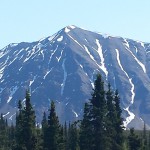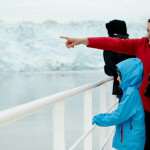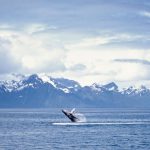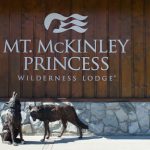Cruising America’s ‘Great Land’ could just be one of your life’s greatest journeys. It was for me.
By sea, it is nearly 850 miles from Seattle to Ketchikan, at the southern tip of the Alaskan Panhandle. Nearly a decade ago, I endured the journey by ship, and I was ready to do so again.

I came intending to spend the long summer days marveling at sublime snow-laden mountains, great rivers of ice, and the misty fjords between the Canadian border and the nutrient-rich waters that give the Inside Passage so much life.
I came hoping to see whales, bears, eagles and other wildlife — and the mighty glaciers beyond Ketchikan.
I wanted to fully immerse myself and learn something of this American outpost, which maps remind me, is separated at its far western border from Russia by a mere 56-mile stretch of sea.
No matter how many times you visit Alaska, there is something about the majestic land that tugs at the traveler to return. And so I packed my suitcase with sweaters, wool socks, pants and boots, and set off with a friend to explore the Great Land.
Remote Alaska
In the summer of 1890, 5,000 visitors cruised the Inside Passage, many of them traveling on the Pacific Coast Steamship Company. Summers today, Alaska can be downright crowded with cruise passengers, but there are still opportunities to experience its remoteness.
If the thought of sharing Juneau with 10,000 other tourists on a busy day makes you queasy, you can always fly away from the crowds by seaplane or helicopter to a remote glacier or lose them on a lonely trail in the forest at Mendenhall Glacier.
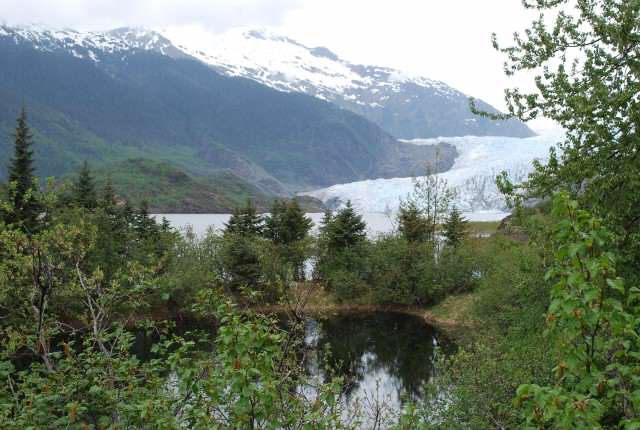 I left Seattle shortly after 5 and traveled overnight through Puget Sound and up the Gulf of Georgia. Our ship was following the route of the early explorers. On the first full morning of our trip, we steered up Canada’s Inside Passage toward Desolation Sound, named by British Captain George Vancouver.
I left Seattle shortly after 5 and traveled overnight through Puget Sound and up the Gulf of Georgia. Our ship was following the route of the early explorers. On the first full morning of our trip, we steered up Canada’s Inside Passage toward Desolation Sound, named by British Captain George Vancouver.
The seasoned explorer must have been awed by the rolling landscape. The shore was wooded and green with spruce and hemlock forests, largely devoid of people and homes, but with a fair amount of commerce taking place on the water.
Ferries shuttled passengers across the wide Gulf of Georgia, from mainland British Columbia to Vancouver Island. Parcels of logs floated along the water’s edge, waiting to be transported to mills. Tugs pulled or pushed barges laden with supplies. Oyster farms inhabited quiet, pond-surfaced coves.
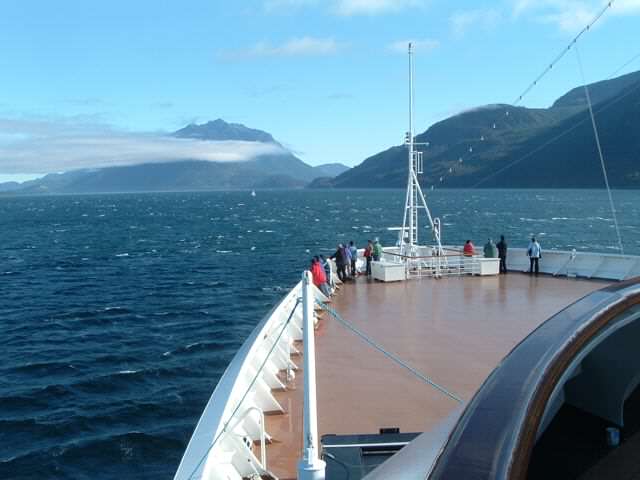 That afternoon we chugged along the Johnstone Strait, known as one of the world’s best areas for sighting Orcas, where we saw several pods of these killer whales surfacing as they fed.
That afternoon we chugged along the Johnstone Strait, known as one of the world’s best areas for sighting Orcas, where we saw several pods of these killer whales surfacing as they fed.
The next morning, our captain detoured to Pringle Rock, where we watched harbor seals lazing on the rocky beaches. During our quiet journey along the desolate British Columbia coast, we saw bald eagles perched in their nests and others soaring overhead. We looked out on beautiful green forests crowning the rocky coast.
There were few signs of human life, an abandoned village here and there. This was the least populated coastal area that we would pass on our journey. The canneries that once bustled with activity here have been largely abandoned. With refrigeration, fishing boats can now store their catch on board until they reach the centralized processing plants. We sailed along Princess Royal Island, a wildlife refuge for the rare kermode bear, and continued making our way up the coast.
The next morning, we awoke to Misty Fjords National Monument. Glacially carved granite walls rose from the sea to heights of more than 3,000 feet. Thin wisps of clouds crowned the ridgelines, and my eyes followed waterfalls that tumbled from the clouds to such eerily still water that it seemed as if we were sitting atop glass.
 We cruised through the fjords, motors barely engaged. We stood in silent awe. Some tried to capture the beauty on camera, but nothing short of being here could do justice.
We cruised through the fjords, motors barely engaged. We stood in silent awe. Some tried to capture the beauty on camera, but nothing short of being here could do justice.
We left Misty Fjords, sailing for Ketchikan, just 22 miles north. We were eager to stretch our legs and fortunate that our arrival in Ketchikan was not accompanied by rain. Whereas Seattle, considered to be rainy and overcast, receives slightly more than three feet of rain annually, Ketchikan is doused with more than 15 feet of the wet stuff each year.
Alaska’s “Rain Capital” was also known through its history as “Alaska’s First City,” for being the first Alaskan port of call for those traveling north on the Inside Passage, and “Salmon Capital of the World,” for its abundant salmon runs. The town had changed much since our last trip here. Shops selling gold, art and souvenirs lined the waterfront on land reclaimed from the harbor.
We disembarked and walked through town to the Southeast Alaska Discovery Center. We toured four informative exhibits highlighting the region’s rainforests, native traditions, ecosystems and natural resources.
We planned to walk to Deer Mountain and hike up through the verdant forest we walked through seven years ago, but on the way, we passed the Great Alaskan Lumberjack Show. What stopped us was not the “90 minutes of excitement” promised in the brochure: “Rugged Woodsmen featured in chopping, sawing, climbing, log rolling, music and more!”
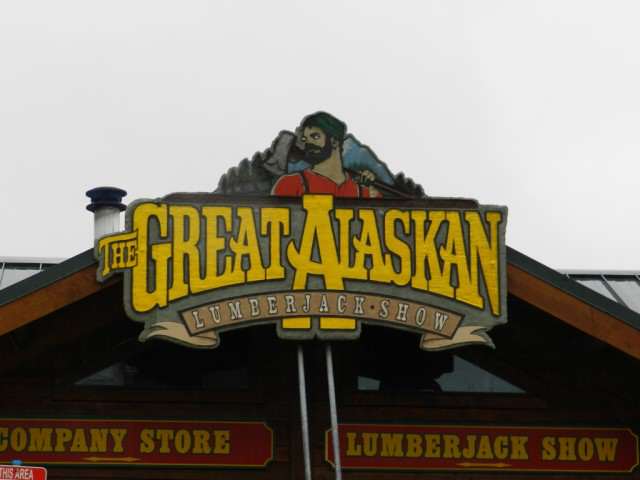 What stopped us were the rental bicycles parked out front. We paid $15 each for a half-day rental, donned a couple of helmets that were included in the rate and began pedaling to Totem Bight State Park, 10 miles away.
What stopped us were the rental bicycles parked out front. We paid $15 each for a half-day rental, donned a couple of helmets that were included in the rate and began pedaling to Totem Bight State Park, 10 miles away.
At Totem Bight, we followed a path by foot through ancient, green forests to a promontory of beachfront featuring an Alaskan Indian communal house and a collection of totem poles. The setting was beautiful, and the totem poles were engaging. After half an hour there, we straddled our bikes and headed back into town.
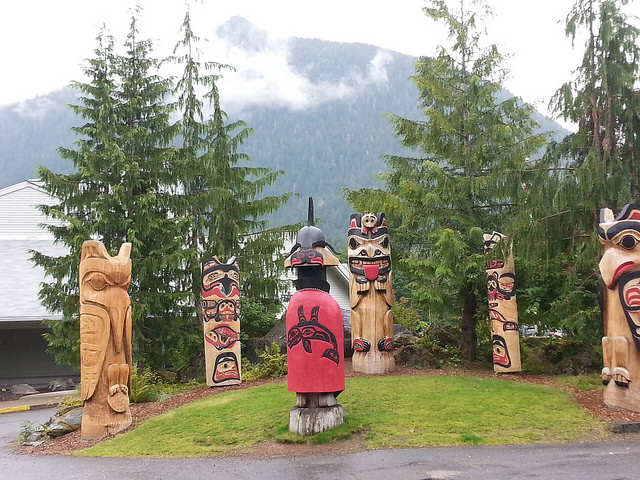 The trip left us not only invigorated but also in need of nourishment. After returning the bikes, we stumbled upon the Ketchikan Brewing Company. The bartender looked surprised to see a couple of tourists pass through the threshold of his bar, and he was: Although the brewery had been around for a few years, the pub had been open only for a few days. We were among the first customers.
The trip left us not only invigorated but also in need of nourishment. After returning the bikes, we stumbled upon the Ketchikan Brewing Company. The bartender looked surprised to see a couple of tourists pass through the threshold of his bar, and he was: Although the brewery had been around for a few years, the pub had been open only for a few days. We were among the first customers.
We sampled Spruce Tip Ale, flavored with hand-picked, locally grown spruce tips; Black Bear Porter, a smoky, chocolate-flavored beer that gets its taste from roasted malts and barley; and Gateway Golden Ale, named for another Ketchikan moniker, “The Gateway City.” And even though we did not hike Deer Mountain, we had a glass of Deer Mountain Amber.
The next morning, we cruised Frederick Sound, where we stopped for more than an hour to watch humpback whales surface and dive, fluking their massive tails. We continued to Stephen’s Passage and up into Tracy Arm, a steep-walled fjord more than 25 miles long that is regarded by some travelers as the most beautiful place in Alaska.
Our cruise took us to Skagway, where we strode the plank walkway of the main street. Shops selling souvenirs and gold have replaced the bars and saloons of 1898 when Skagway was a Klondike Gold Rush Town of 20,000 men and women eager to strike it rich.
We rented bikes and rode 10 miles to Dyea, an abandoned town at the trailhead of the Chilkoot Trail. Our ride along paved and gravel roads rose and fell along the shoreline, and we arrived in Dyea after an hour. In a gravel parking lot, a display depicted the blueprint of the ghost town. As we made our way down the forested and dirt streets (some now grown over), we tried to imagine what it must have been like for the green horns in search of gold.
 They would have been required by the Canadian Mounted Police to transport one-year’s provisions over imposing Chilkoot Pass. The prospectors carried as much as 1,000 pounds on mules and horses, until reaching the trail’s most notorious stretch, the Golden Stairs, a 30-degree grade just below the summit.
They would have been required by the Canadian Mounted Police to transport one-year’s provisions over imposing Chilkoot Pass. The prospectors carried as much as 1,000 pounds on mules and horses, until reaching the trail’s most notorious stretch, the Golden Stairs, a 30-degree grade just below the summit.
Once there, they descended to Lindemann or Bennett lakes, where they built boats and floated 550 miles to the gold rush fields in Dawson City. They endured all of this in the hardened hope that they might strike it rich -or die trying.
When the narrow-gauge White Pass & Yukon Route railroad was completed in July 1900, Dyea faded into a ghost town. All that remains now is the facade of a storefront.

The next morning, we cruised into Glacier Bay. There are an estimated 100,000 glaciers in Alaska covering 29,000 square miles – an equivalent land mass of nearly four New Jerseys – and Glacier Bay National Park is the best place to see them. The glaciers here are remnants of the ‘Little Ice Age’ that began 4,000 years ago. In 1750, melting began.
When Captain Vancouver sailed here in 1794, he found Icy Strait choked with ice. The glacier responsible was more than 4,000-feet thick, up to 20 miles or more wide and extended more than 100 miles. A century later, naturalist John Muir found that the ice had retreated 48 miles, and by 1916, the ice was 65 miles from Glacier Bay’s mouth. Such rapid retreat is known nowhere else in the world.
The rapid melting raises an interesting, if not disturbing, point. Glaciers and polar ice store more water than lakes and rivers, groundwater and the atmosphere combined. If all the world’s glaciers melted, half of the world’s cities would be inundated with water.
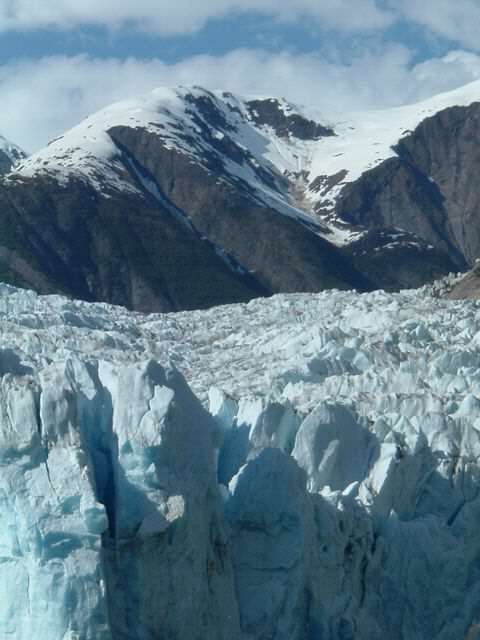 That night, we stood on the upper decks of the ship, awed by the majestic landscape and buoyed by bubbly champagne. The sky was streaked with pink. Two humpback whales were feeding nearby. It was immensely beautiful. On the shoreline, perhaps, 300 yards away, we could see four people sitting on a log. Their kayaks were propped beside them. I could not tell how far we were from the nearest town – Juneau is 65 miles from Glacier Bay – but their beachhead looked to be remote and desolate.
That night, we stood on the upper decks of the ship, awed by the majestic landscape and buoyed by bubbly champagne. The sky was streaked with pink. Two humpback whales were feeding nearby. It was immensely beautiful. On the shoreline, perhaps, 300 yards away, we could see four people sitting on a log. Their kayaks were propped beside them. I could not tell how far we were from the nearest town – Juneau is 65 miles from Glacier Bay – but their beachhead looked to be remote and desolate.
That is the beauty of Alaska. You can still find a place to yourself, an unoccupied beach to sit on. We had come to Alaska to see wildlife and natural wonders, and to experience the remoteness of this wild land. Our journey was ending, and as we boarded the flight to return home, we already knew we would return yet again to this majestic land.
Editor’s Note: This is an updated blog post originally published in 2012 by Ralph Grizzle.
Are you ready to see Alaska for the first time or maybe see Alaska in a whole new way with a land tour in addition to your cruise? Our specialists can help you find the perfect fit and guide you through all the questions you might have!
